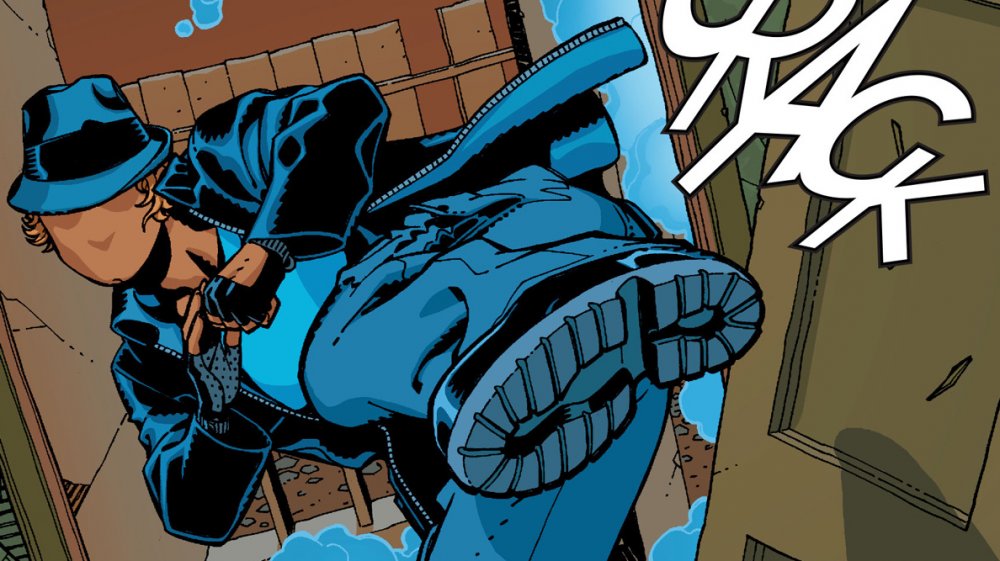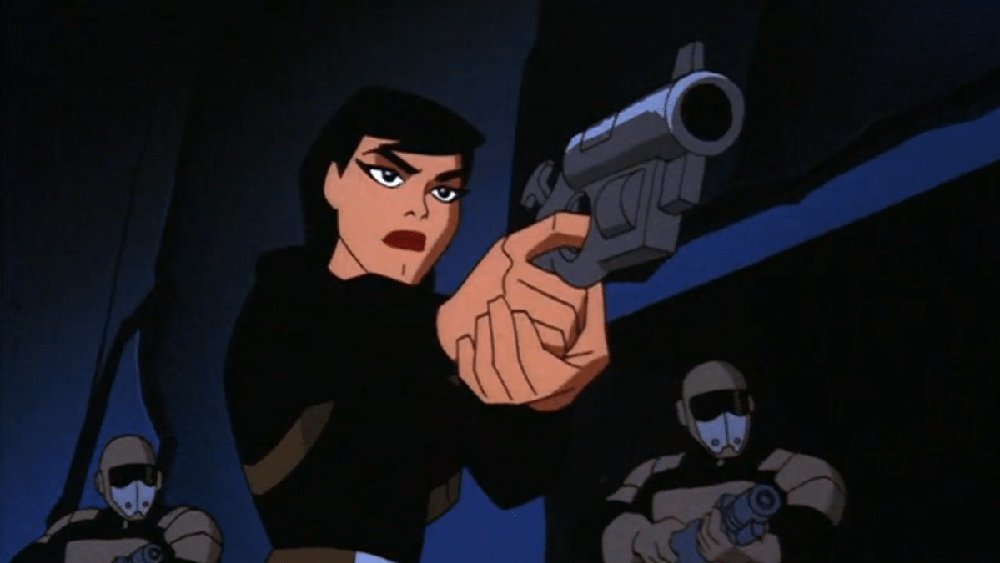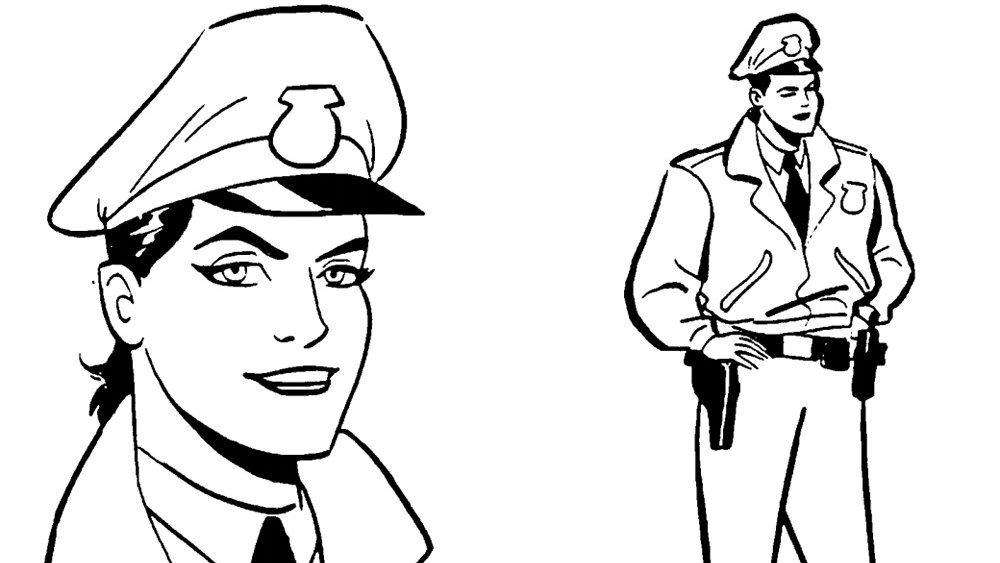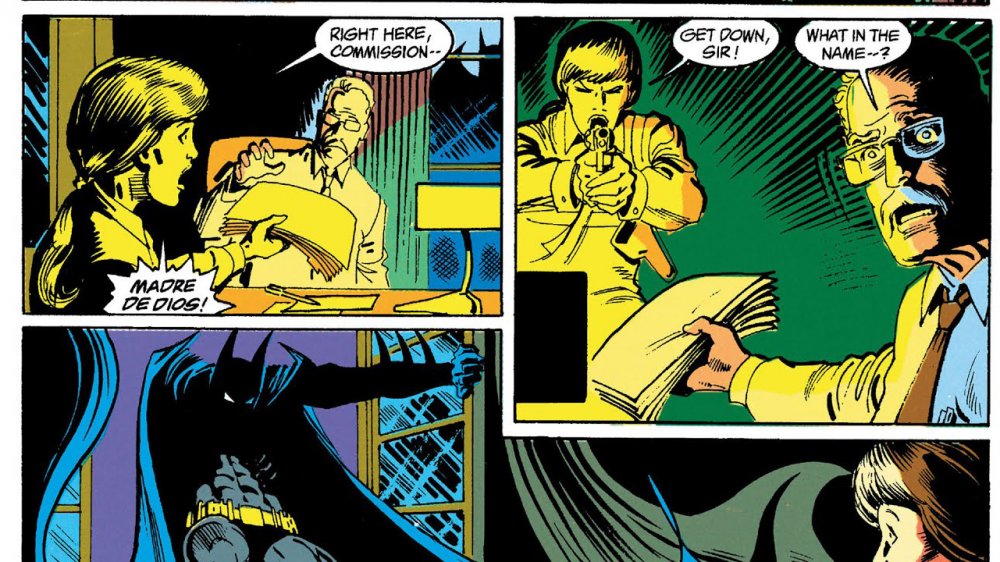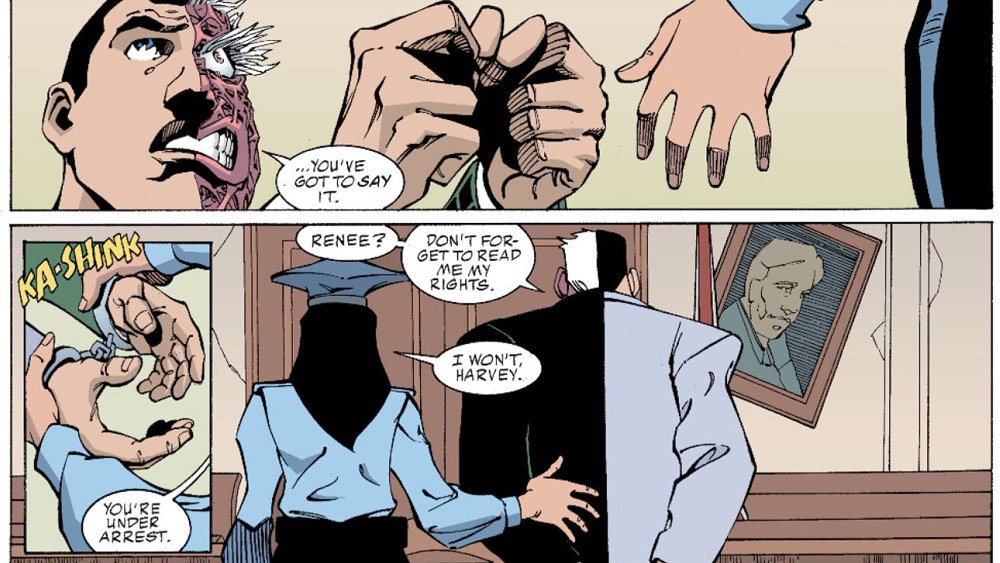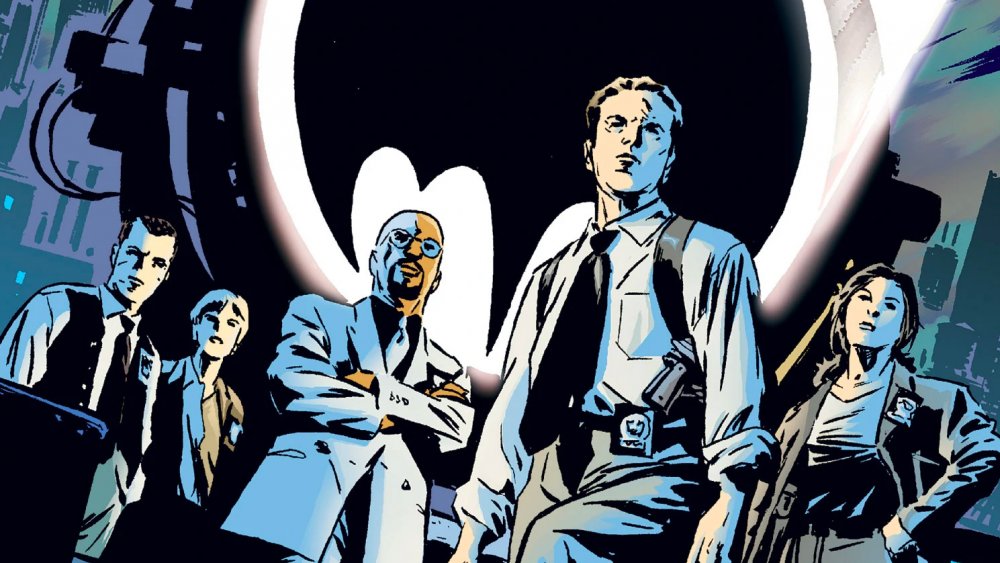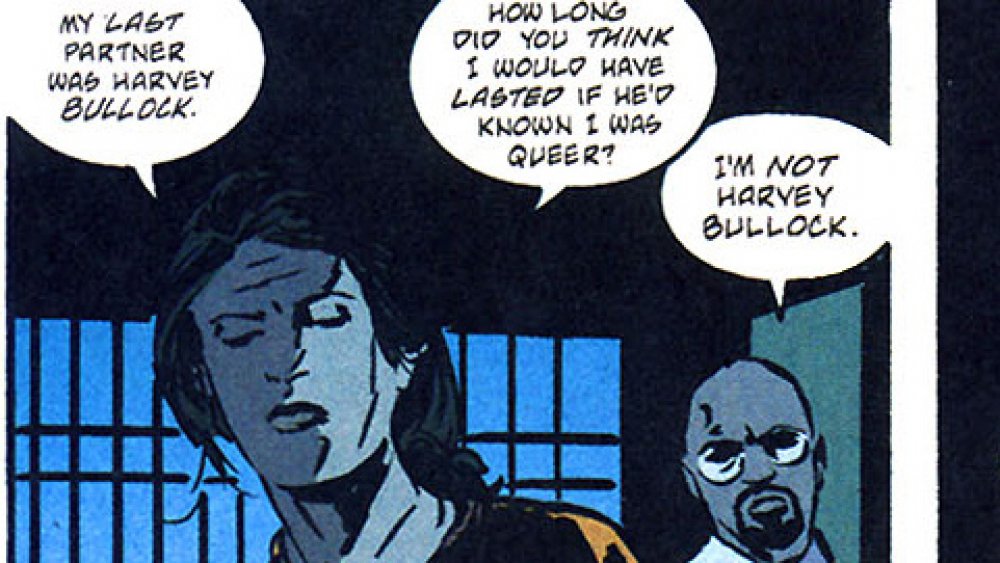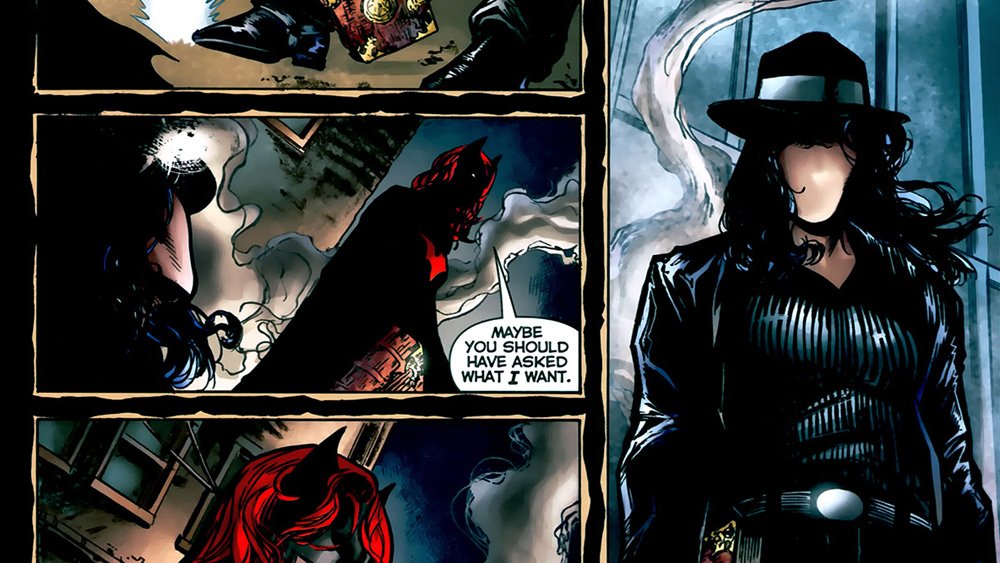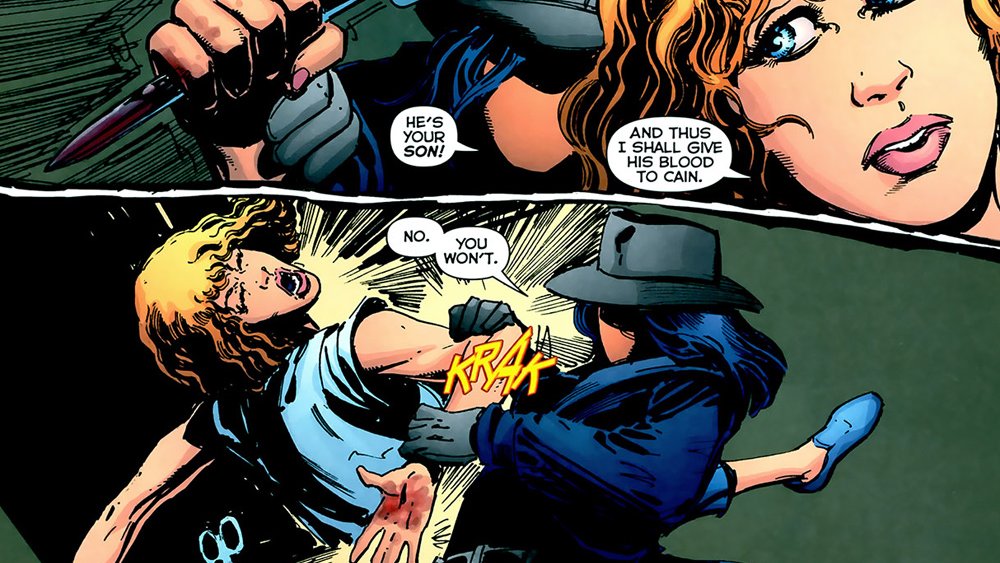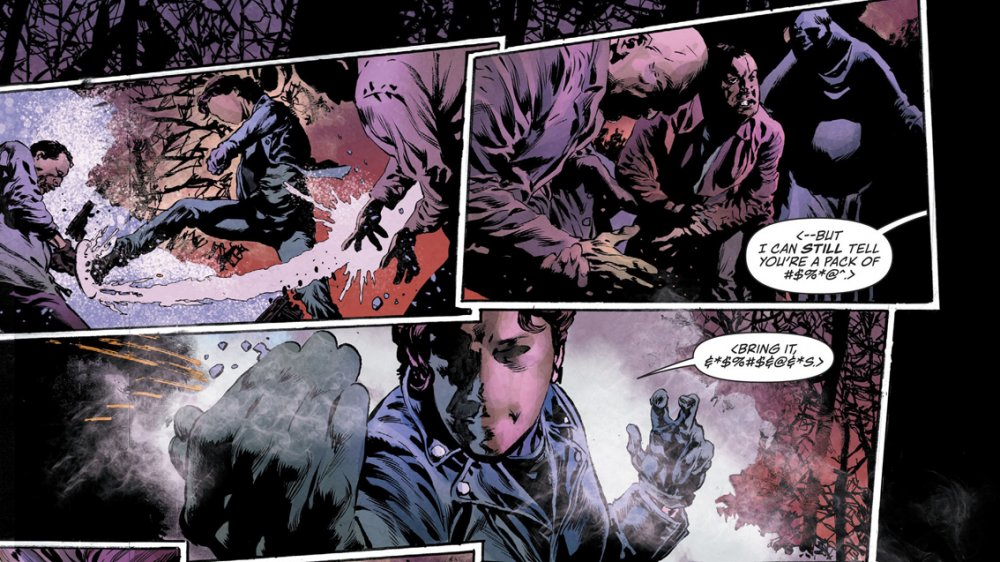The Untold Truth Of Renee Montoya
Gotham CIty's most famous resident is unquestionably Batman, but he's not the only comic book hero to set up shop in that famously crime-ridden metropolis. He's got a handful of Robins and a couple of Batgirls hanging around, Jonah Hex occasionally dropped by back in the last days of the wild west, and Tommy Monaghan spent 60 issues of Hitman hanging out at a sleazy bar in one of Gotham's worst neighborhoods — and those are just the headliners. Dig a little deeper and you'll find Orpheus, Mother Panic, Ragman, and even more.
But not every notable Gotham Citizen wears a mask to fight crime — not all the time, anyway. For proof, look no further than Renee Montoya. While she would eventually find her own superheroic identity, it was only after she spent nearly two decades evolving from a relatively simple cartoon character to the most compelling member of the Gotham City Police department to one of DC's most prominent lesbian characters. How did she get there? Good question. For the answers, read on and find the untold truth of Renee Montoya.
The animated origins of Renee Montoya
While she's been a prominent character in the pages of DC Comics for a quarter century, Renee Montoya didn't start out on the page. Like Harley Quinn, she was originally created for Batman: The Animated Series, joining Jimmy Olsen, Kryptonite, and Spider-Man's amazing friend Firestar on the list of things that were imported to comics from other media.
She wasn't the most prominent character on the show, or even the most prominent member of the show's supporting cast, an honor that was probably split between Alfred and Commissioner Gordon. She was, however, a recognizable, recurring character, appearing in 17 of the show's 109 episodes. She even got the spotlight in one of them, "P.O.V.," and while the episode itself is a forgettable sort of Rashomon ripoff that doesn't actually do the one thing that makes Rashomon work — showing the way people can perceive or describe the same event differently rather than just telling the same story three times — it solidified her as a mainstay of the show.
Unfortunately, being one of exactly three members of the GCPD who actually had a name and a recurring role was about all she got on the show. The animated Renee Montoya was essentially just an Odd Couple foil for her partner, Harvey Bullock, who had been around in the comics for a while. He was a slovenly, angry, cigar-chomping grump with a chip on his shoulder who didn't mind breaking the rules to get results; Renee was the beleaguered, by-the-book cop who was trying to uphold the law in a city full of villains and vigilantes. Originally, though, she was meant to be a little more complicated.
The Batman Bible
While developing Batman: The Animated Series in 1992, writers Paul Dini and Mitch Brian and artist and character designer Bruce Timm produced a 153-page "bible" for the show, laying out exactly how they wanted to approach the character and what would set their version apart from previous screen Batmans. If you read through it today, you might be surprised to see just how much of what made the show a classic was there from the very beginning, including an attempt to make the show feel timeless by explicitly forbidding most references to pop culture.
There are a few things, though, that never made it to the show, and a lot of them come from the detailed biography we get for the animated version of Renee Montoya. There's an entire backstory and motivation there that was never brought up on the show, including the idea that Montoya "hates Bruce Wayne and everything he stands for" because she thinks he's "selfish and deaf to the cries of Gotham's poor."
The most surprising piece of that backstory to her modern fans, given how her character evolved in the comics over the years, is likely her motivation for becoming a police officer. The original idea was to give her an origin that would thematically tie her to Bruce Wayne, explaining that "her husband, also a police officer, was killed two years ago in the line of duty." While there are plenty of lesbians who have been married to men for a variety of reasons, it seems likely that this particular element of Renee's character, one which would become one of her defining characteristics over the past 15 years, was entirely a later addition.
Then again, maybe it's not that much of a shock. Getting an explicitly gay character onto a cartoon for kids in 1992 would've likely been incredibly difficult. The supporting cast of Superman: The Animated Series featured Maggie Sawyer, another police officer, who had become DC's first canonical lesbian character all the way back in 1988. In 1998, six years after Renee Montoya made her debut, there was only a brief, mostly subtextual acknowledgement of this on STAS when Maggie's girlfriend showed up at the hospital after Maggie was injured in the line of duty.
Renee hits the page
While she had been created for the animated series, a weird quirk of scheduling and the longer lead time for animation meant that she actually debuted in the comics a few months before she appeared on the show. Batman #475 introduced her as Jim Gordon's new assistant in March of 1992, while "Pretty Poison," the animated series episode in which both Montoya and Poison Ivy made their first appearances, wouldn't actually air until September.
For a long time, the Renee Montoya of the comics was a lot like her animated counterpart: essentially just a generic Good Cop, and one of the few incorruptible officers on whom Gordon and Batman could rely in the notoriously crooked GCPD. The first time that she really got to show her character was during the Knightfall crossover. That story is largely remembered for the moment where Bane breaks Batman's back and puts him out of action, one of the most iconic pages in the Dark Knight's long history. Equally important but far less remembered is the first part of Bane's plan. In order to wear Batman down to the point where he can effortlessly snap his spine, Bane breaks out the entire criminal population of Arkham Asylum, forcing Batman — and the GCPD — to work overtime to bring them all down.
It was during that time that Renee proved herself to be more than just a generic cop. She was the first one on the GCPD to realize that the mass breakout was just a means to target Batman, and after freeing herself from being held at knifepoint by the serial killer Mr. Zsasz, she was the one who stopped a Batman who had been driven to the breaking point from going over the edge and killing the bad guy. In other words, that big event crossover was good for Montoya's character development, a trend that would continue through the end of the decade.
No Man's Land
In 1999, the Batman titles embarked on a massive crossover that was set to run for a whole year, with at least one issue coming out every single week. It was called No Man's Land, and it basically mashed up the Dark Knight and Mad Max in a pseudo-post-apocalyptic adventure. The setup came in a story called Cataclysm, where Gotham was devastated by an earthquake that hit 7.6 on the Richter scale — about the magnitude of the famous 1906 earthquake that destroyed 80% of San Francisco. Rather than rebuilding, the government declared Gotham a lost cause, evacuating the city as a "no man's land" and leaving the survivors who couldn't get out to the mercy of the villains who were carving Gotham up into their own apocalyptic kingdoms.
Naturally, most of the good guys stayed behind, too, Renee Montoya among them. Along with the rest of the major GCPD characters — including Gordon, Bullock, and a fascist, trigger happy SWAT leader named William Pettit — she remained in Gotham, hoping to protect the people stuck there long enough for things to be rebuilt. It was also during this time that Renee would develop what would become one of the most important elements of her character: her relationship with Two-Face.
Under writer Greg Rucka, who would go on to become the primary architect of Renee's evolution over the next ten years, Two-Face was revealed to have something of a pseudo-romantic obsession with Renee. During No Man's Land, he kidnapped not only her, but her entire family, holding them hostage until he decided to put Jim Gordon on trial. Renee was forced to serve as both a bailiff and a witness for the prosecution, while Dent acted as judge, jury, prosecutor, and, after being convinced with a coin flip, attorney for the defense. While Renee would obviously never return his "romantic" obsession, seeing how shattered his psyche had become as Two-Face did give her sympathy for Harvey Dent as a person. Unfortunately, that obsession would remain even after Gotham was rebuilt.
Gotham Central
After No Man's Land, the Batman books underwent a soft relaunch with new creative teams and a new mandate for each title to focus on a different aspect of Batman. Detective Comics, as its name implies, was geared more towards crime stories — but, you know, crime stories that still had Batman and Ra's al-Ghul in them. That naturally came with a new spotlight on the police, including Renee Montoya, and after the dynamics of the rebuilt GCPD were established there, the cops were spun off into their own title.
Gotham Central, written by Greg Rucka and Ed Brubaker with art by Michael Lark, immediately became a critical darling thanks to its take on a simple question that the Batman titles had been asking for decades: what's it like to be a cop in a city full of supervillains, where the law is primarily enforced by a superhero dressed up like Dracula?
The answer, it turns out, is "it's extremely difficult" Over the course of the series, the cops in the GCPD's Major Crimes Unit — the section of the department saddled with anything involving a supervillain — had to deal with being targeted by criminals with ice guns, finding dead sidekicks in the street, and more. The series was frequently pretty dark, in a way that felt gritty and realistic without ever denying that it existed in a universe full of telepathic gorillas and Green Lantern rings. Nearly 20 years after its launch, it still stands out as one of the most well-regarded comics of the era, and its influence can be felt beyond comics — especially in the Christopher Nolan Dark Knight films and, of course, the TV show Gotham.
Half a Life
Gotham Central's sixth issue kicked off a story arc called "Half a Life," in which Renee Montoya was outed as a lesbian to her coworkers and family — and, incidentally, to the readers. To make matters worse, the guy who did the outing and the PI that he'd paid to take "incriminating" photos of Renee and her girlfriend wound up murdered, shot by Renee's gun. While the outing appeared to be revenge by a criminal Montoya had arrested, the whole thing, including the murders and the frame-up, were orchestrated by someone else: Two-Face.
Harvey Dent's obsession with Renee had fueled Two-Face's plan to systematically destroy everything in her life. In outing her, he ruined her fragile relationship with her conservative parents, while framing and kidnapping her in what appeared to be an escape made her a fugitive, isolating her from her work life. The idea was that with everything destroyed, Renee would finally have nothing to keep her from returning Two-Face's love. Fortunately for Renee, her partner, Cris Allen, believed her. Along with Batman, they cleared her name.
"Half a Life" was a massive critical success, winning multiple awards, including the Eisner Award for Best Serialized Story. It also rocketed Renee Montoya to fame as DC's highest profile gay character, and paved the way for the next step in her evolution.
Good Question
Gotham Central would continue to run for a few years after "Half a Life," with Renee remaining one of the book's main characters. The bad news for Renee was that those years chronicled her life continuing to get worse, as the lasting stress from Two-Face's attack drove her into a spiral of drinking and violence that ended with her resigning from the GCPD and being left by her girlfriend. The good news was only for the readers — as hard as it was to see Renee being put through the wringer, it made for some very compelling drama.
In the 2006 comic 52, which filled in the gaps of a year where Superman, Batman, and Wonder Woman were all out of action after the events of a massive crossover, Renee encountered Vic Sage, better known as the masked hero the Question. Having similarly gone through a pretty rough time in his own groundbreaking series back in the '80s, Vic had emerged as a sort of Zen crimefighter, and hoped to bring Renee out of the depths of her depression and train her as his successor. Vic, known to Renee as "Charlie" (it's complicated), was dying, and after leading Renee on a literal and figurative journey of self-discovery, he died, asking her who she was going to become.
The answer... was the Question. After "Charlie" died, Renee took the identity of the Question for herself, using it to find meaning in her life. And also to get involved in one of the strangest DC stories of the 2000s.
The Crime Bible
Renee's tenure as the Question didn't last long until the DC Universe was rebooted in 2011. As a result, she didn't get a lot of stories in her new identity, and the one she did get is mainly memorable for being... well, extremely weird, even by the standards of the rest of the DC Universe.
The whole thing centered on the Crime Bible, which is exactly what you think it is by reading those two words. It's a Bible, but for crimes. Focused on Cain — who you may remember from the regular non-crime Bible as the first person to ever do a murder — the Crime Bible taught "lessons of blood" to its adherents. The actual contents were left pretty vague, presumably because "Crime Bible" is not a title that requires a whole lot of elaboration, but it was definitely compelling enough to spark an entire "Religion of Crime" that had its own factions, complete with prophecies concerning the "twice-named Daughter of Cain" and "the Faceless One." Needless to say, the former was Kate Kane, better known as Batwoman, and the latter was Renee Montoya, whose mask as the Question had the effect of making her look like she had no face.
The idea of superheroes fighting cultists who worship crime as a concept — and who may or may not be manipulated by Darkseid, the evil alien god of the planet Apokolips — is a good one with a lot of potential for strange superhero action. It was also a definite departure from the more grounded adventures that had focused on both Renee herself and the Question for years. Looking back from over a decade later, it sadly feels more like a weird divergence than anything that was going somewhere. That could always change, though. If there's one lesson to learn from comics, it's that nothing ever really goes away.
A Question for Lois
Aside from being mentioned as an ex-girlfriend of Kate Kane's in Batwoman, Renee Montoya had been mostly absent from the DC Universe since the "New 52" reboot in 2011, and the Question as a concept was taken in some pretty weird directions. For a while, the Question wasn't even Vic Sage, it was an unnamed immortal figure who had been punished for his sins by wizards who removed his facial features, and who was briefly on a team with Pandora (who unleashed all evil on the world in Greek Mythology), and Judas (from the Bible — the non-crime one). If we're ranking stories that feel like weird divergences, that one's probably at the top.
In 2019, however, the Superman titles got an influx of new creative teams. Superman and Action Comics were taken over by Brian Michael Bendis — best known for his work on Ultimate Spider-Man and The Avengers during his two decades at Marvel, where he co-created Miles Morales, among others. A new Superman's Pal Jimmy Olsen series launched for the first time since the '70s under Hawkeye writer Matt Fraction and Superior Foes of Spider-Man artist Steve Lieber. There was also a new Lois Lane title, drawn by Mike Perkins and written by Greg Rucka.
If you've been paying attention to the names of the creators so far, you can probably guess where this is going. Sure enough, Lois Lane #1 saw the return of Renee Montoya as the Question, helping Lois investigate a death that was tied to the super-criminal Leviathan. It was while she was snooping around for Lois that she encountered someone dressed in the classic Question costume, who unmasked and revealed himself to be Vic Sage. The only problem was that he was the same Vic Sage who had died in her arms way back in 2007 — real-world 2007, that is. The conversation that followed implied that they remembered their history from before the DC Universe was rebooted, but also knew that those events never happened in this version of their universe. In a very literal sense, that encounter left readers with... a couple of Questions.
